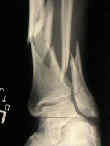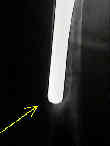- Discussion:
- disadvantages of external fixation:
- pin tract infections, delayed union / non-union, and malunion;
- cosmetic problems;
- advantages of external fixation:
- technically easy to perform;
- no soft tissue stripping;
- ease of removing hardware;
- comparison of IM nailing vs external fixation
- Initial Considerations
- compartment syndrome:
- w/ a difficult fracture reduction, consider making the fasciotomy incision slightly closer to the tibia so that the fracture site
can be palpated and bone holding clamps can be applied;
- vascular injuries associated w/ tibial frx;
- provisional external fixation should be applied first so that manipulation of the frx will not disrupt the anatomosis;
- ensure that the proposed frame will not interfere w/ subsequent revascularization procedures;
- open fractures:
- debridment:
- aggressive & repeated debridments of all devitalized tissue, including bone fragments;
- soft tissue lacerations should be temporarily closed w/ towel clips prior to application of the fixator so that the wound edges
are not gaped open by the half pins;
- likewise, fasciotomy incision should be temporarily closed w/ towel clips towel clips so that the fixator pins do not cause
the wound to gape open;
- soft tissue coverage for the leg
- ensure that the proposed frame will not interfere w/ subsequent reconstructive procedures;
- references:
- The role of supplemental lag-screw fixation for open fractures of the tibial shaft treated with external fixation.
- Open tibial fractures treated by anterior half-pin frame fixation.
- Severe open tibial fractures. Results treating 202 injuries with external fixation.
- Plates versus external fixation in severe open tibial shaft fractures. A randomized trial.
- The management of open tibial fractures with associated soft-tissue loss: external pin fixation with early flap coverage.
- Complicated open fractures of the distal tibia treated by secondary interlocking nailing.
- Operative Considerations
- enhancement of fixator stability;
- safe zone of pin insertion:
- foot inclusion: may be indicated for open fractures and distal fractures;
- choice of hardware:
- uniplanar fixators:
- Synthes:
- Orthofix fixator;
- circular wire fixators:
- Ilizarov Menu
- Synthes Hybrid Fixator
- Orthofix Hybrid System;
- dynamization:
- alawys consider the need for postoperative dynamization, hence plan the configuration to allow for shortening;
- this is especially important for the orthofix fixator since postoperative shortening will not be possible unless the fixator is
initially lengthened;
- reduction:
- usually should be carried out prior to fixator application;
- plane of the fixator:
- consider the need for soft tissue coverage and position the fixator in way that not to interfere with free flap coverage;
- because major bending moments on tibia during gait are in saggital plane, placment of fixator pins and frame near the
saggital plane improves stability;
- comminuted fractures: (or oblique frx)
- if frx is comminuted or oblique fracture fragments will not transmit axial load;
- these frx require stacked frame for enhanced stability;
- see: enhancement of fixator stability;
- diaphyeal fractures:
- appropriate length is fitted with 4 pin holding clamps;
- place most proximal & distal holding clamps as far apart as possible
- proximal pin is placed, preferably at junction of diaphysis and metaphysis, to gain purchase in the thick cortical bone;
- place inner holding clamps approx 2 cm from frx site;
- proximal frx:
- see:
- tibial plateau frx
- considerations for IM nailing of proximal tibial frx;
- small proximal tibal fragment can be stabilized w/ external fixator using a cluster of 2-3 transfixation pins from lateral to medial,
alternatively a hybrid circular wire fixator may be required;
- generally, the first half pin is inserted into shorter fragment;
- half pins should be placed at least 1-2 cm from the joint line in order to avoid possible septic arthritis (this may be especially
important in diabetics);
- if a cancellous site is chosen, the hole is drilled only with the 3.5 mm drill, and a 5.0 mm Schanz screw is used;
- reference: Safe extracapsular placement of proximal tibia transfixation pins.
- external fixation for distal tibia frx: (see pilon fracture)
- Post Operative Care and Complications:
- bone grafting for tibial fracture
- exchange IM nailing
- non-union
- prognosis for healing
One-Stage External Fixation Using a Locking Plate: Experience in 116 Tibial Fractures
Plates versus external fixation in severe open tibial shaft fractures. A randomized trial.
Tibial external fixation, weight bearing, and fracture movement.
Analysis of the external fixator pin-bone interface.
The role of external fixation in the treatment of posttraumatic osteomyelitis.
Severe open tibial fractures. Results treating 202 injuries with external fixation.
Mechanical Influences on Tibial Fracture Healing.
RhBMP-7 accelerates the healing in distal tibial fractures treated by external fixation.
Staged external and internal locked plating for open distal tibial fractures
Staged Protocol in Treatment of Open Distal Tibia Fracture: Using Lateral MIPO



